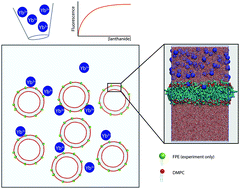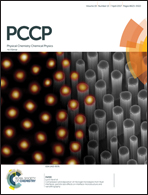How does ytterbium chloride interact with DMPC bilayers? A computational and experimental study†
Abstract
Lanthanide salts have been studied for many years, primarily in Nuclear Magnetic Resonance (NMR) experiments of mixed lipid–protein systems and more recently to study lipid flip-flop in model membrane systems. It is well recognised that lanthanide salts can influence the behaviour of both lipid and protein systems, however a full molecular level description of lipid–lanthanide interactions is still outstanding. Here we present a study of lanthanide–bilayer interactions, using molecular dynamics computer simulations, fluorescence electrostatic potential experiments and nuclear magnetic resonance. Computer simulations reveal the microscopic structure of DMPC lipid bilayers in the presence of Yb3+, and a surprising ability of the membranes to adsorb significant concentrations of Yb3+ without disrupting the overall membrane structure. At concentrations commonly used in NMR experiments, Yb3+ ions bind strongly to 5 lipids, inducing a small decrease of the area per lipid and a slight increase of the ordering of the aliphatic chains and the bilayer thickness. The area compressibility modulus increases by a factor of two, with respect to the free-salt case, showing that Yb3+ ions make the bilayer more rigid. These modifications of the bilayer properties should be taken into account in the interpretation of NMR experiments.



 Please wait while we load your content...
Please wait while we load your content...